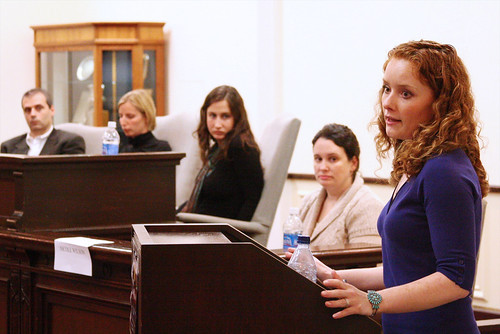In light of dog fighting’s growth as a legal issue nationwide, the Student Animal Legal Defense Fund held a discussion at Beasley School of Law.

Though dogs are “man’s best friend,” some owners take advantage of the relationship by exploiting them for sport.
Dog fighting received national media attention after NFL quarterback Michael Vick was found guilty for organizing a dog-ring operation two years ago.
In light of his recent move to the Philadelphia Eagles, the Temple Student Animal Legal Defense Fund held a panel discussion last Thursday to promote education about dog fighting and the laws that protect animal rights.
The panel included a journalist, an author, a humane officer, a dog trainer and an owner of a dog behavior center, each of whom spoke about their own personal experiences with dog fighting.
“A big issue with animal laws is that people are unaware of the laws. We want to make it more available and more known,” said second-year law student Jesse Paine, who also serves as co-president of the SALDF.
Federal law states that when tried in court, the “animal client” will always remain innocent. Since 2008, it has become a felony to participate as a dog owner or spectator during a dogfight.
But dog fighting has become a prevalent concern in Philadelphia and other major cities, explained Jim Gorant, a senior editor at Sports Illustrated.
“For the first time ever in courts, dogs became viewed as the victims of the crime, not the instigator, because these rings, most of the time, involve drugs, gambling and other things the police are concerned about,” he said.
Marisa Scully, a certified professional dog trainer, explained that pit bulls are “like warriors” and the most common breed in the ring, although breeds vary. She described pit bulls as mentally capable and athletic with a high pain tolerance, which are vital qualities to sustain them in the ring.
“They don’t discriminate when it comes to fighting another dog. It’s all they know,” she said, adding that pit bulls are usually submissive to people.
“Pit bulls can just destroy other animals if they want. But they also have great personalities and can be a positive influence to families. They can be great pets,” she said.
But not all “warrior” dogs can be rehabilitated to become family pets, said Leigh Siegfried, owner of Opportunity Barks Behavior and Training.
“It takes a lot of stress relief and positive exercise. We give them behavior evaluations to screen for potential aggressions and tolerance training, but unfortunately there is no fool-proof way to get them to become house-trained,” she said. Considering a dog adoptable, she added, remains a controversial issue due to a lack of formal guidelines.
Ken Foster, author of The Dogs Who Found Me, said he believes part of the reason pit bulls are difficult to find family-oriented owners for are the slew of negative stereotypes that can come with owning a pit bull.
“When I first saw a pit bull, I just thought it was any other dog. I didn’t think it was scary looking or anything. Shelters will deny them sometimes, though, and people will give me looks sometimes when I’m with my dogs,” he said.
A question-and-answer session followed the panel discussion, which Paine said indicated that people are not only connecting with animals, but are mobilizing to help with animal rights.
“Everyone learned something they didn’t know, and some learned a ton that they didn’t know,” she said. “Most importantly, it connected people to change laws, to have those laws enforced and for the misconceptions and prejudices of pit bulls to be corrected. The more people we have carrying those messages or contacting their elected representatives, the better.”
Matthew Petrillo can be reached at mattp@temple.edu.



Thank you Matt Petrillo for covering this event!
I just want to clarify that Federal law does not “state” that animal clients are always innocent. Rather, animals are used as the gun to commit a crime, but they aren’t the ones who pull the trigger. Animal exploitation comes in many forms, and one of those forms is physically and psychologically training a dog to be dangerous to others.
Just a note on the quote below….
——–
But not all “warrior” dogs can be rehabilitated to become family pets, said Leigh Siegfried, owner of Opportunity Barks Behavior and Training.
“It takes a lot of stress relief and positive exercise. We give them behavior evaluations to screen for potential aggressions and tolerance training, but unfortunately there is no fool-proof way to get them to become house-trained,” she said. Considering a dog adoptable, she added, remains a controversial issue due to a lack of formal guidelines.
———
Yep, not all dogs that are fighting dogs are able to be placed in homes because they are more than the average adopter is “up” for. Those that aren’t placed are typically truly dog aggressive (as in “an intention to do harm”) and highly reactive (barking/lunging) towards other animals. Not only are they a liability to an organization placing them, they may be a potential liability in an adopter’s home.
However, many dogs are placed and ideally are social (have a need for people, enjoy petting and being handled) and are dog social or dog tolerant (may be reactive, but don’t necessarily have an intention to do harm).
Re: to get them “housetrained”, I think what the author is alluding to is having them adapt to life in a home. Just removing these dogs from a stressful environment and giving them stress relief (exercise, enrichment, interaction with humans or other dogs, if dog social), is the first step in normalcy and a chance at life outside the ring.
Adoptability? Yep, how it is defined varies from organization to organization and the resources that they have at their fingertips. In my opinion, it’s time to have some standards for “rescue” in general, so that the consumer can count on a “good” rescue experience regardless of who they work with to adopt!